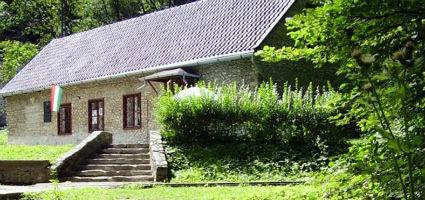2024. November 22. Friday
Hungarian Museum for Science, Technology and Transport - Massa Museum - Miskolc - Hámor
 |
Address: 3517, Miskolc - Hámor Ómassai út
Phone number: (46) 370-864
E-mail: kohmuz@kohmuz.t-online.hu
Opening hours: 15.04-15.10: Tue-Fri 9-17
16.10.2011- 15.04.2012.: closed |
Museum tickets, service costs:
|
Ticket for adults
|
500 HUF
|
/ capita
|
|
Ticket for students
|
250 HUF
|
/ capita
|
|
Group ticket for students
|
250 HUF
|
/ capita
|
|
Ticket for pensioners
|
250 HUF
|
/ capita
|
|
Ticket for families
(2 adults + more children)
|
1100 HUF
|
/ family
|
|
Group guide
(1-5 people)
|
400 HUF
|
/ capita
|
|
Group guide
(6-20 people)
|
3200 HUF
|
/ group
|
|
Group guide
(20 people)
|
5500 HUF
|
/ group
|
|
Group guide
|
8500 HUF
|
/ group
|
|
Photography
|
500 HUF
|
|
|
Video
|
1200 HUF
|
Hungary's first industrial scheduled monument is located next to the Massa Museum. The building is the wood burning grand smelter, the so-called 'ancient furnace'. Its history goes back to the 18th century.
The goldsmith master Fazola Henrik, whose world-famous rococo-style works can be found in Eger, built an iron works in the region of Miskolc-Ómassa with the leave of Maria Teresa in 1770. His son, Frigyes, who had excellent results in the establishment of Hungarian steel production, first built a dam along the banks of Garadna during 1810-1812 which resulted in the Lake Hámori. Then, in 1813, he built a more modern forge in Újmassa.
The forge that was rebuilt in 1831 was last operated in 1872 after the Iron Factory of Diósgyőr was built in 1870. The forge was reconstructed in the middle of the 20th century, partly in its original form. The forge is known as the oldest industrial building in Hungary.
The Treasury spent considerable amount on the protection of the factory, thus, it may be a greater experience than ever before.
The goldsmith master Fazola Henrik, whose world-famous rococo-style works can be found in Eger, built an iron works in the region of Miskolc-Ómassa with the leave of Maria Teresa in 1770. His son, Frigyes, who had excellent results in the establishment of Hungarian steel production, first built a dam along the banks of Garadna during 1810-1812 which resulted in the Lake Hámori. Then, in 1813, he built a more modern forge in Újmassa.
The forge that was rebuilt in 1831 was last operated in 1872 after the Iron Factory of Diósgyőr was built in 1870. The forge was reconstructed in the middle of the 20th century, partly in its original form. The forge is known as the oldest industrial building in Hungary.
The Treasury spent considerable amount on the protection of the factory, thus, it may be a greater experience than ever before.